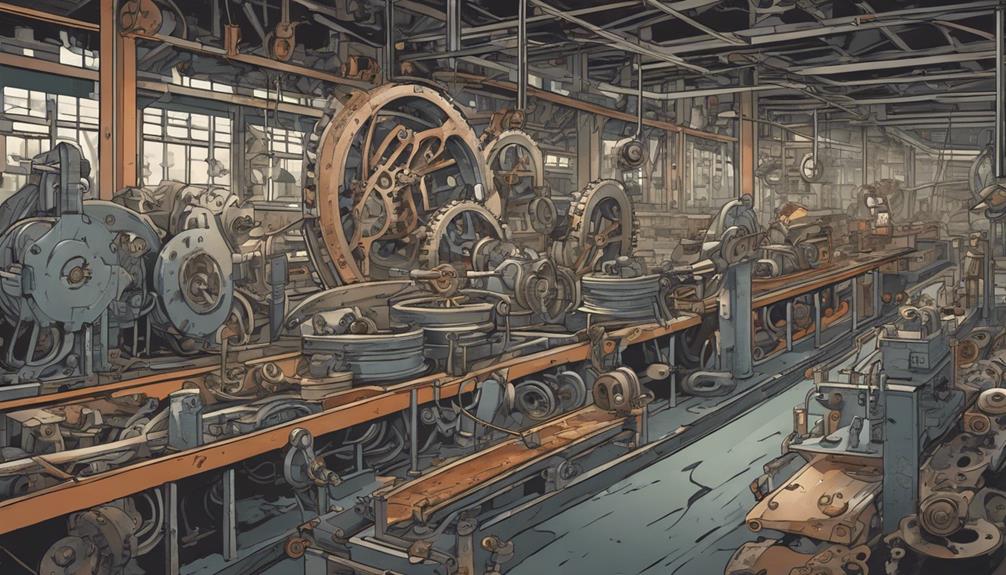Mitigating component obsolescence risk requires a multi-faceted approach. Identify and track obsolete components proactively, implementing a systematic process to shorten the lifecycle of integrated circuits. Establish thorough end-of-life policies, guaranteeing compliance with regulations and a smooth phase-out process. Continuously monitor and update component lifecycles, conducting regular assessments and reviews. Prioritize modernization efforts, upgrading technology to enhance system reliability and efficiency. Finally, foster cross-functional collaboration to pool expertise and develop innovative solutions. By adopting these strategies, electronic systems can minimize downtime and uphold long-term performance, and exploring these strategies further can reveal additional benefits.
Key Takeaways
- Implement proactive identification and tracking of obsolete components to mitigate supply chain disruptions and ensure business continuity.
- Establish clear end-of-life policies to ensure compliance with regulations and a smooth phase-out process with minimal downtime.
- Continuously monitor and update component lifecycle status, supply chain risks, industry trends, and design architecture to stay ahead of obsolescence.
- Prioritize modernization efforts by systematically eliminating obsolete components, upgrading to new technologies, and enhancing system reliability and efficiency.
- Foster cross-functional collaboration among design engineers, obsolescence managers, and electronics manufacturing experts to develop innovative solutions and mitigate obsolescence risks.
Identify and Track Obsolete Components
To effectively mitigate the risks associated with component obsolescence, it is essential to implement a proactive approach to identifying and tracking obsolete components, given that a staggering 15% of electronic components disappear annually.
This essential approach is vital, as component obsolescence can notably shorten the lifecycle of integrated circuits (ICs) by 30%. Additionally, over 50% of ICs have a lifespan of under five years, highlighting the urgency to identify and monitor obsolete components.
The impact of mergers and acquisitions on the global component supply chain, affecting over 200 billion components, further underscores the need for accurate tracking of obsolete parts. By specifying long-term availability components, manufacturers can mitigate risks associated with tracking obsolete components.
A detailed tracking system enables the identification of obsolete components, allowing for timely replacement and minimizing the risk of supply chain disruptions. By adopting a proactive approach to identifying and tracking obsolete components, manufacturers can ensure the continuity of their production processes and minimize the risks associated with component obsolescence.
Establish End-of-Life Policies

Establishing thorough end-of-life policies is an important step in managing component obsolescence. It enables manufacturers to systematically retire outdated components and mitigate associated risks. These policies outline procedures for retiring outdated components, ensuring a structured phase-out process that minimizes disruptions to production and supply chains.
Moreover, end-of-life policies guarantee compliance with regulations and standards for product disposal, reducing the risk of non-compliance and associated penalties. By having a clear plan in place, manufacturers can smoothly shift to newer technologies, reducing risks associated with obsolete components.
Effective end-of-life policies facilitate the management of component obsolescence, enabling manufacturers to reduce risks and maintain compliance. By implementing these policies, manufacturers can guarantee a smooth shift to new components, maintaining production efficiency and minimizing downtime. By doing so, they can reduce the risks associated with component obsolescence, ultimately protecting their business and reputation.
Continuously Monitor and Update

Regular monitoring of component lifecycle statuses and proactive adaptation to changing market conditions are essential in mitigating component obsolescence risks. This involves staying informed about technological advancements and industry trends to anticipate potential obsolescence risks. By continuously monitoring and evaluating component availability, organizations can identify potential risks and update their obsolescence management strategies accordingly.
| Monitoring Activity | Frequency |
|---|---|
| Component lifecycle status checks | Quarterly |
| Supply chain risk assessment | Bi-annually |
| Review of industry trends and advancements | Annually |
| Evaluation of hardware and software compatibility | Semi-annually |
| Review of design and system architecture | Tri-annually |
Prioritize Modernization Efforts

By prioritizing modernization efforts, organizations can systematically eliminate obsolete components, thereby mitigating the risks associated with component obsolescence and ensuring compliance with industry standards and regulations.
This proactive approach enables design teams to make informed decisions, leveraging best practices to upgrade technology and minimize operational risks. By investing in modernization initiatives, organizations can enhance long-term system reliability and efficiency, reducing the likelihood of downtime and improving overall system performance.
A dedicated obsolescence strategy ensures that outdated components are identified and replaced, aligning with the organization's Quality Management System. By doing so, organizations can guarantee that their systems remain up-to-date, reducing the risk of obsolescence and ensuring continued compliance with industry regulations.
Foster Cross-Functional Collaboration

To effectively mitigate component obsolescence risks, organizations must also foster cross-functional collaboration, which enables diverse teams to pool their expertise and develop all-encompassing strategies to address obsolescence proactively. This collaboration involves teams from different departments, including design engineers, obsolescence managers, and electronics manufacturing experts, working together to identify and manage obsolescence risks. By sharing knowledge and expertise, teams can develop innovative solutions to combat component obsolescence, ensuring that the total system is considered.
| Collaborative Effort | Benefits |
|---|---|
| Design Engineers + Obsolescence Managers | Identify EOL components in the bill of materials |
| Electronics Manufacturing Experts + Design Engineers | Develop alternative components that comply with Restriction of Hazardous Substances |
| Obsolescence Managers + Electronics Manufacturing Experts | Implement successful obsolescence strategies, ensuring minimal disruption to operations |
Through cross-functional collaboration, organizations can create a proactive approach to identifying and managing obsolescence risks, ensuring that the total system is considered and minimizing the impact of component obsolescence on operations. By pooling expertise, organizations can develop extensive mitigation strategies, ultimately leading to successful obsolescence management.
Frequently Asked Questions
How Do You Mitigate Risk of Obsolescence?
Mitigating the risk of obsolescence is like maneuvering through a treacherous landscape, requiring precision and foresight. To avoid being stranded, it is crucial to implement proactive measures.
This involves staying informed about product lifecycle stages, developing a thorough management plan, and identifying alternative sourcing options for critical components.
Regularly reviewing and updating strategies ensures adaptability in the face of uncertainty, minimizing the risk of obsolescence and ensuring continued operational excellence.
Which Technique Is Used to Control Obsolescence?
To control obsolescence, various techniques are employed. Proactive obsolescence management, lifecycle tracking, and strategic sourcing are commonly utilized.
Additionally, obsolescence forecasting, alternative sourcing options, and component lifecycle analysis are effective control measures.
These techniques involve monitoring component availability, identifying end-of-life dates, and engaging with multiple suppliers.
How to Minimize Obsolescence?
While obsolescence can be a crippling threat to system reliability, proactive measures can effectively minimize its impact. To minimize obsolescence, a multi-faceted approach is essential.
This includes establishing a robust supply chain, implementing lifecycle management, and leveraging forecasting tools to anticipate and adapt to component changes.
What Is Planned Obsolescence Strategy to Reduce Risk?
Planned obsolescence is a deliberate design strategy where products are crafted with a limited lifespan, prompting consumers to purchase newer versions. This approach fuels repeat business, but it also contributes to component obsolescence, exacerbating electronic waste and environmental concerns.


